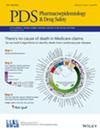Exposure to Valsartan Products Containing Nitrosamine Impurities in the United States, Canada, and Denmark
IF 2.4
4区 医学
Q3 PHARMACOLOGY & PHARMACY
引用次数: 0
Abstract
BackgroundFollowing the mass recall of valsartan products with nitrosamine impurities in July 2018, the number of patients exposed to these products, the duration of exposure, and the potential for cancer remains unknown. Therefore, we assessed the extent and duration of use of valsartan products with a nitrosamine impurity in the United States, Canada, and Denmark.MethodsWe conducted a retrospective cohort study using administrative healthcare data from the US FDA Sentinel System, four Canadian provinces that contribute to the Canadian Network for Observational Drug Effect Studies (CNODES), and the Danish National Prescription Registry. Patients, 18 years and older between May 2012 and December 2020 with a valsartan dispensing were identified in each database. Patients were followed from the date of valsartan dispensing until discontinuation. We defined four valsartan exposure categories based on nitrosamine impurity status; recalled generic products with confirmed NDMA/NDEA levels (recalled‐tested); recalled generic products that were not tested (recalled); non‐recalled generic and non‐recalled branded products. In Denmark, the recalled‐tested category was not included due to absence of testing data. The proportion and duration of use of valsartan episodes stratified by nitrosamine‐impurity status was calculated.ResultsWe identified 3.3 and 2.8 million (United States) and 51.3 and 229 thousand (Canada) recalled‐tested and recalled valsartan exposures. In Denmark, where valsartan exposure was generally low, there were 10 747 recalled exposures. Immediately after the recall notices were issued, there was increased rates of switching to a non‐valsartan ARB. The mean duration of use of the recalled‐tested products was 167 (±223.1) and 146 (±255.8) days in the United States and Canada respectively. For the recalled products, mean cumulative duration of use was 178 (±249.6), 269 (±397.3) and 166 (±251.0) days in the United States, Canada, and Denmark, respectively.ConclusionIn this cohort study, despite widespread use of recalled generic valsartan between 2012 and 2018, the duration of use was relatively short and probably did not pose an elevated risk of nitrosamine‐induced cancer. However, since products with nitrosamine impurity could have been on the market over a 6‐year period, patients exposed to these products for longer durations could have a potentially different risk of cancer.美国、加拿大和丹麦与含有亚硝胺杂质的缬沙坦产品的接触情况
背景在2018年7月大规模召回含有亚硝胺杂质的缬沙坦产品后,暴露于这些产品的患者人数、暴露持续时间以及致癌的可能性仍然未知。因此,我们评估了含有亚硝胺杂质的缬沙坦产品在美国、加拿大和丹麦的使用范围和持续时间。方法我们利用来自美国 FDA 哨兵系统、为加拿大药物效应观察研究网络(CNODES)做出贡献的四个加拿大省份以及丹麦国家处方登记处的行政医疗保健数据,开展了一项回顾性队列研究。每个数据库都确定了 2012 年 5 月至 2020 年 12 月期间配发过缬沙坦的 18 岁及以上患者。从配发缬沙坦之日起对患者进行随访,直至停药。我们根据亚硝胺杂质状况定义了四种缬沙坦暴露类别:NDMA/NDEA 含量得到证实的已召回仿制药产品(已召回检测);未进行检测的已召回仿制药产品(已召回);未召回仿制药产品和未召回品牌药产品。在丹麦,由于缺乏检测数据,召回检测类产品未包括在内。结果我们分别发现了330万次和280万次(美国)以及5130万次和22.9万次(加拿大)经过召回检测和召回的缬沙坦暴露。在缬沙坦暴露量普遍较低的丹麦,召回的缬沙坦暴露量为 10 747 例。召回通知发布后,立即改用非缬沙坦类抗心律失常药物的比例有所上升。在美国和加拿大,召回测试产品的平均使用时间分别为167天(±223.1)和146天(±255.8)。对于召回产品,美国、加拿大和丹麦的平均累计使用时间分别为178(±249.6)天、269(±397.3)天和166(±251.0)天。结论在这项队列研究中,尽管在2012年至2018年期间广泛使用了召回的仿制缬沙坦,但使用时间相对较短,可能不会导致亚硝胺诱发癌症的风险升高。然而,由于含有亚硝胺杂质的产品可能已在市场上销售了6年之久,接触这些产品时间较长的患者可能会有不同的癌症风险。
本文章由计算机程序翻译,如有差异,请以英文原文为准。
求助全文
约1分钟内获得全文
求助全文
来源期刊
CiteScore
4.80
自引率
7.70%
发文量
173
审稿时长
3 months
期刊介绍:
The aim of Pharmacoepidemiology and Drug Safety is to provide an international forum for the communication and evaluation of data, methods and opinion in the discipline of pharmacoepidemiology. The Journal publishes peer-reviewed reports of original research, invited reviews and a variety of guest editorials and commentaries embracing scientific, medical, statistical, legal and economic aspects of pharmacoepidemiology and post-marketing surveillance of drug safety. Appropriate material in these categories may also be considered for publication as a Brief Report.
Particular areas of interest include:
design, analysis, results, and interpretation of studies looking at the benefit or safety of specific pharmaceuticals, biologics, or medical devices, including studies in pharmacovigilance, postmarketing surveillance, pharmacoeconomics, patient safety, molecular pharmacoepidemiology, or any other study within the broad field of pharmacoepidemiology;
comparative effectiveness research relating to pharmaceuticals, biologics, and medical devices. Comparative effectiveness research is the generation and synthesis of evidence that compares the benefits and harms of alternative methods to prevent, diagnose, treat, and monitor a clinical condition, as these methods are truly used in the real world;
methodologic contributions of relevance to pharmacoepidemiology, whether original contributions, reviews of existing methods, or tutorials for how to apply the methods of pharmacoepidemiology;
assessments of harm versus benefit in drug therapy;
patterns of drug utilization;
relationships between pharmacoepidemiology and the formulation and interpretation of regulatory guidelines;
evaluations of risk management plans and programmes relating to pharmaceuticals, biologics and medical devices.

 求助内容:
求助内容: 应助结果提醒方式:
应助结果提醒方式:


